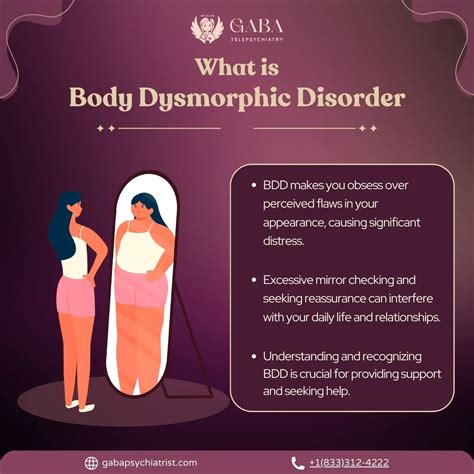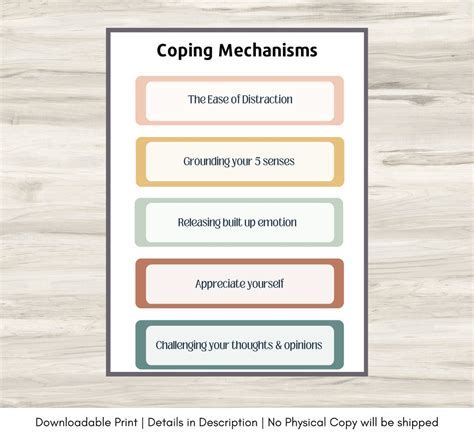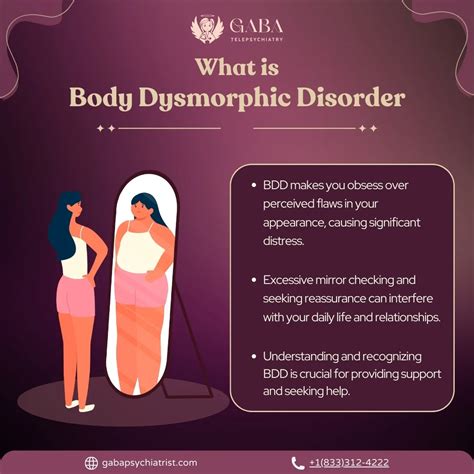Intro
Discover Body Dysmorphic Disorder (BDD) symptoms, causes, and treatments. Learn about this mental health condition, its effects on self-esteem, and related disorders like anxiety and depression, to understand the complexities of BDD.
Body Dysmorphic Disorder (BDD) is a serious mental health condition characterized by an obsessive preoccupation with a perceived flaw in one's appearance. This flaw may be minor or even imaginary, but to the individual with BDD, it is a significant source of distress and anxiety. People with BDD often spend excessive amounts of time thinking about their appearance, trying to hide or fix the perceived flaw, and seeking reassurance from others. This preoccupation can interfere with daily life, social relationships, and overall well-being.
The symptoms of BDD can vary widely, but common characteristics include a persistent and intrusive preoccupation with a perceived defect or flaw in one's appearance, such as skin, hair, or facial features. This preoccupation is not just a passing concern, but rather a dominant and recurring thought pattern that can be difficult to control. Individuals with BDD may also exhibit repetitive behaviors, such as excessive grooming, checking mirrors or reflective surfaces, or seeking reassurance from others. These behaviors are often performed in an attempt to alleviate anxiety or distress related to the perceived flaw.
BDD can have a significant impact on an individual's quality of life, leading to social isolation, depression, and anxiety. It can also interfere with daily activities, such as work, school, or social interactions, and can lead to avoidance behaviors, such as avoiding social situations or public places. In severe cases, BDD can lead to suicidal thoughts or behaviors, highlighting the need for prompt and effective treatment.
Understanding the Causes of Body Dysmorphic Disorder

The exact causes of BDD are not fully understood, but research suggests that it is a complex condition involving a combination of genetic, environmental, and psychological factors. Genetic predisposition, brain chemistry, and cultural and societal pressures can all contribute to the development of BDD. Additionally, traumatic experiences, such as bullying or abuse, can also play a role in the development of the condition. Understanding the underlying causes of BDD is essential for developing effective treatment strategies and providing support to individuals affected by the condition.
Genetic Factors
Genetic factors are thought to play a role in the development of BDD, with research suggesting that individuals with a family history of BDD or other mental health conditions may be more likely to develop the condition. Brain chemistry, including imbalances in neurotransmitters such as serotonin, can also contribute to the development of BDD. Further research is needed to fully understand the genetic and neurobiological mechanisms underlying BDD.Environmental Factors
Environmental factors, such as cultural and societal pressures, can also contribute to the development of BDD. The media's portrayal of unrealistic beauty standards, the emphasis on physical appearance in social media, and the availability of cosmetic surgery and other appearance-enhancing procedures can all contribute to body dissatisfaction and the development of BDD. Traumatic experiences, such as bullying or abuse, can also play a role in the development of the condition.Diagnosis and Treatment of Body Dysmorphic Disorder

Diagnosing BDD can be challenging, as the condition often co-occurs with other mental health conditions, such as depression or anxiety. A comprehensive diagnostic evaluation, including a physical examination, psychological assessment, and laboratory tests, is necessary to rule out other conditions and confirm a diagnosis of BDD. Treatment for BDD typically involves a combination of psychotherapy, medication, and self-help strategies.
Psychotherapy
Psychotherapy, such as cognitive-behavioral therapy (CBT), can be an effective treatment for BDD. CBT helps individuals identify and challenge negative thought patterns and behaviors associated with BDD, and develop more adaptive coping strategies. Other forms of psychotherapy, such as psychodynamic therapy, may also be helpful in addressing underlying emotional and psychological issues contributing to BDD.Medication
Medication, such as selective serotonin reuptake inhibitors (SSRIs), can be used to help manage symptoms of BDD, such as anxiety and depression. However, medication should be used in conjunction with psychotherapy, as it is unlikely to address the underlying causes of the condition.Living with Body Dysmorphic Disorder

Living with BDD can be challenging, but there are many strategies that can help individuals manage their symptoms and improve their quality of life. Self-help strategies, such as practicing self-compassion, challenging negative thoughts, and engaging in activities that promote relaxation and stress reduction, can be helpful in managing symptoms of BDD. Support groups, either in-person or online, can provide a sense of community and connection with others who are experiencing similar challenges.
Self-Help Strategies
Self-help strategies can be an effective way to manage symptoms of BDD. Practicing self-compassion, challenging negative thoughts, and engaging in activities that promote relaxation and stress reduction can all be helpful in reducing symptoms of BDD. Additionally, engaging in activities that promote self-esteem and body satisfaction, such as exercise or creative pursuits, can also be beneficial.Support Groups
Support groups, either in-person or online, can provide a sense of community and connection with others who are experiencing similar challenges. Sharing experiences and receiving support from others can be a powerful way to manage symptoms of BDD and improve overall well-being.Prevention and Early Intervention

Prevention and early intervention are critical in reducing the risk of developing BDD and improving treatment outcomes. Promoting positive body image, self-esteem, and self-compassion can help reduce the risk of developing BDD. Early intervention, such as seeking professional help at the first signs of symptoms, can also improve treatment outcomes and reduce the risk of long-term complications.
Promoting Positive Body Image
Promoting positive body image, self-esteem, and self-compassion can help reduce the risk of developing BDD. Encouraging individuals to focus on their strengths and abilities, rather than their appearance, can help promote a more positive body image. Additionally, promoting diversity and inclusivity in media and advertising can help reduce the pressure to conform to unrealistic beauty standards.Early Intervention
Early intervention, such as seeking professional help at the first signs of symptoms, can also improve treatment outcomes and reduce the risk of long-term complications. Identifying warning signs, such as excessive preoccupation with appearance or repetitive behaviors, can help individuals seek help early, reducing the risk of developing more severe symptoms.What is Body Dysmorphic Disorder?
+Body Dysmorphic Disorder (BDD) is a serious mental health condition characterized by an obsessive preoccupation with a perceived flaw in one's appearance.
What are the symptoms of Body Dysmorphic Disorder?
+The symptoms of BDD include a persistent and intrusive preoccupation with a perceived defect or flaw in one's appearance, repetitive behaviors, and social isolation.
How is Body Dysmorphic Disorder treated?
+Treatment for BDD typically involves a combination of psychotherapy, medication, and self-help strategies, such as cognitive-behavioral therapy (CBT) and selective serotonin reuptake inhibitors (SSRIs).
In conclusion, Body Dysmorphic Disorder is a serious mental health condition that can have a significant impact on an individual's quality of life. Understanding the causes, symptoms, and treatment options for BDD is essential for providing effective support and care. By promoting positive body image, self-esteem, and self-compassion, and seeking professional help at the first signs of symptoms, individuals can reduce their risk of developing BDD and improve their overall well-being. We invite you to share your thoughts and experiences with BDD, and to seek help if you or someone you know is struggling with the condition. Together, we can work to promote greater awareness and understanding of BDD, and provide support to those affected by the condition.
